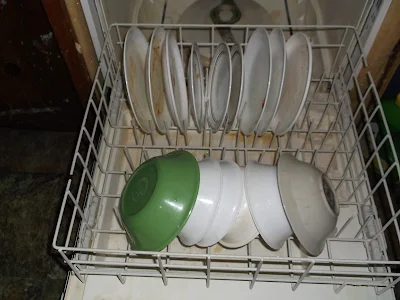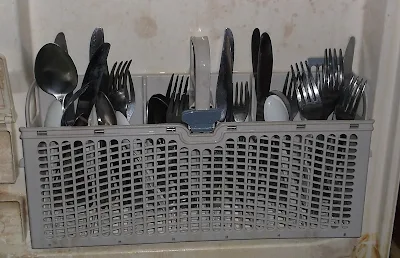Minimum standards
 |
| This is a rack in the dishwasher. The sprayer goes around in the counterclockwise direction in our dishwasher. |
 |
| It cleans better in the center than in the corners. |
 |
| The MINIMUM standard for cups is SIX. Light weight plastic ones toward the front. Heavy glass items near the rear. Top facing down. |
 |
| Peanut butter must be wiped or cleaned from knives before they are placed in the dishwasher. Our dishwasher will not clean peanut butter off the backside of a knife blade. |
 |
| Melted-on cheese must be scraped off of plates before they are put in the dishwasher. Our dishwasher is not capable of cleaning melted-on cheese off of our plates. |
Preferred standard
Launch
 |
| Close dishwasher door. Set to Pot-and-Pans cycle. Turn off "Heated Dry". Flip magnet to "Clean". Push "Start" button. |




I wash mine the old-fashioned way, by hand. By the time I get the dishwasher loaded I can do them by hand. Plus, it gives me better control. For example, my coffee cup only gets washed once a year or so. Otherwise it's rinsed and put in the draining rack.
ReplyDeleteWe don't even own a dishwasher. We used to. And no one would load it correctly (correctly=my way). When it died, we pulled it out and I installed shelves in it's space and use it to store my canning supplies and cookbooks. I'm much happier this way. And I have two kids who make excellent dishwashers!
ReplyDeleteLoading a dishwasher is the new Tetris.
ReplyDeleteGood graphic, and NOT one they want you to see when you buy...
ReplyDelete'Pot-scrubber' cycle...my big ol' butt.
ReplyDeleteI've never encountered a dishwasher, yet, that would remove much of anything dried or cooked on.
Will say that most stuff I've seen written up indicate that a dishwasher uses less water than typical hand-washing... but I doubt it used less than my grandmother - who carried the dishpan out and watered her flowers or doorstep garden with the combined 'dirty' and rinse water.